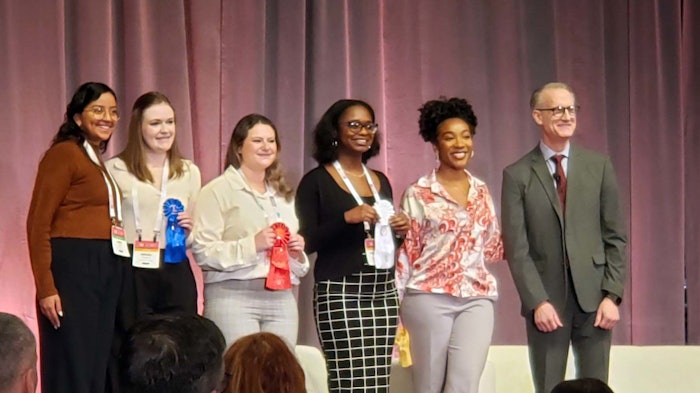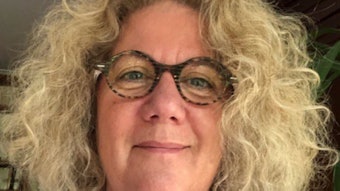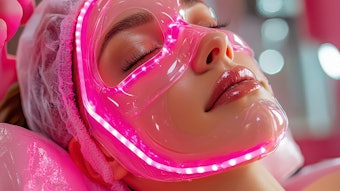
All-inclusive beauty, including acne, hair frizz, cross-cultural age perception and more, and additional advances in skin care — from human recombinant collagen skin care, to a ferment that acts on the holobiont to reduce skin dehydration — led the afternoon sessions on day two of the SCC77 Annual Meeting. This rolled over to the evening networking supplier cocktail reception and various social functions.
 Henry Maso award keynote address by Sarah DaVanzo, of Pierre Fabre
Henry Maso award keynote address by Sarah DaVanzo, of Pierre Fabre
The third and final day kicked off with the awards breakfast, sponsored by Ashland, including the Henry Maso award keynote address by Sarah DaVanzo, of Pierre Fabre, on "insight alchemy" and how to use AI to become "augmented scientists."
Additional morning sessions featured more on AI and beauty, and color and photoprotection — including a new, bio-inspired photonic material that bends light — before breaking for a networking luncheon and more time in the exhibition showcase.
The SCC77 meeting wrapped up with all-important sessions on regulatory and claims, covering everything from animal testing through MoCRA, and formulation design and sustainability touching on surfactants, delivering benefits from botanicals, optimizing skin penetration of caffeine, and more. Following are some highlights.
Awarding Innovation
Student poster awards: First place: Abigail Poehls, Univ. of Cincinnati, "Investigation of Reversible Protein Binding of Solutes in Human Stratum Corneum for Validation of Reservoir Effect;" second place: Casey Posner, University of Toledo, "Transfer-resistant Lipstick: Are Bio-based Film Formers Effective Substitutes for Synthetic Film Formers?"; third place: Raihannah Saffee, University of Toledo, "Hue Neutralizing Effect of Ultramarine Blue in Power Formulations;" and fourth place: Destiny Durante, University of Illinois Chicago, "N-substituted Furopyrroles as Broad-spectrum Filoviral Entry Inhibitors." (sponsored by DD Chemco)
 Madame C.J. Walker Scholarship Winner Precious Ulel with A’Lelia Bundles, great-great granddaughter of Madame C.J. Walker
Madame C.J. Walker Scholarship Winner Precious Ulel with A’Lelia Bundles, great-great granddaughter of Madame C.J. Walker
Madam C.J. Walker scholarships - two $5,000 awards presented to underrepresented minorities who embody the spirit and legacy of Madam Walker; winners: Xylia Ajose and Precious Ulel; finalists: Jada Alcantara and Destiny Durante. (sponsored by Mary Kay)
Alan B. and Jeanette Black award - best paper on sustainable formulation in the past year in JCS or at the SCC76 meeting: Valerie Andre-Frei, "A New Generation of Sustainable Cosmetic Peptides Obtained by Yeast Fermentation." (sponsored by Presperse)
 Madame C.J. Walker Scholarship Winner Xylia Ajose with A’Lelia Bundles, great-great granddaughter of Madame C.J. Walker
Madame C.J. Walker Scholarship Winner Xylia Ajose with A’Lelia Bundles, great-great granddaughter of Madame C.J. Walker
Shaw Mudge award - best paper presented at SCC76, Zhi Li, Ph.D., "Livestreaming to Win: How Chinese Indie Beauty Brands Thrive with Their Marketing Innovations on Mobile Social Platforms." (sponsored by the Mudge family)
Des Goddard Award - most innovative paper or student technical poster on polymer science in JCS or presented at SCC76: Ella Christine Hudson, "Untangling Hair: A Holistic Approach to Hair Damage by Linking Biological and Mechanical Datasets." (sponsored by SCC National)
SCC Award - best paper at SCC76 contributing to knowledge of protection against or ameliorating damage caused by UV: Stellie Balthazard, "How to Best Formulate Aesthetically Pleasing Mineral Sunscreen Products."
All-inclusive Beauty
Combining acne therapies: This session opened with a talk by Hilary Baldwin, M.D., of the Acne Treatment & Research Center, who explained that understanding the medication to use for a given disease phenotype and unique patient circumstance is the art of treating acne; and that most often, a combination therapies is used to fight acne.
Kobo considered chromophores and undertone skin structures, then selected pigments and materials to complement the upper skin tone while including the reflection of the undertone to create perfectly matched shades."
Shade matching in various skin tones: "Creating a Streamlined and Inclusive Shade Palette for the USA & UK and Latin America," was presented by Kathy Cruz, of Kobo Products. Per Cruz, the company considered chromophores and undertone skin structures, then selected pigments and materials to complement the upper skin tone while including the reflection of the undertone to create perfectly matched shades.
Assessing frizzy hair properties: Next up, Roger McMullen, Ph.D. of Ashland, highlighted the physicochemical properties of frizzy hair through the analysis of surface properties, water management properties, and dynamic behavior of individual fibers and hair fiber assemblies when exposed to high humidity, chemistry, mechanical properties and fiber geometry.
Cross-cultural perceptions of beauty: Remo Campiche, Ph.D., of dsm-firmenich, described a multiethnic and multicultural approach to address predictors of female age, health and attractiveness perception from the skin feature analysis of digital images in five ethnic groups. This work found that age assessments within and between ethnicities varied less than attractiveness and health assessments.
'Triple Temperance' approach to oily skin: Rounding out the session, Philip Ludwig, of BASF France, described a in vitro and in vivo work in 34 Asian women using an Epilobium angustifolium extract to balance three common issues in oily skin. Assessments included: lipid production in sebaceous glands and sebocytes from multiethnic origins; bacterial lipase activity to reduce the bacterial degradation of lipids, in turn avoiding skin irritation; and anti-inflammatory and antioxidant properties to boost skin defenses.
Skin Care Advancements
Human-inspired recombinant collagen to improve skin structure: In parallel, the afternoon session continued with presentations on advances in skin care. Anne Yun Mu, of Evonik Corp., described the development of a human-inspired recombinant collagen as a sustainable alternative to animal collagen. "Collagen is the key to skin's structural integrity," explained Mu, who noted it is lost at a rate of 1% per year with aging. "[We combined a] deeper understanding of molecular biology and fermentation expertise to create revolutionary vegan collagen."
The human collagen III-inspired recombinant 50 kDa protein is produced in yeast and reportedly 100% identical to the N-terminus of the human type III collagen. The company's work addressed technological challenges for the industrialization of such recombinant protein as well as working mechanisms in terms of ECM and DEJ structural stability and boosting.
Photoaged skin, with a scar-like dermis, is characterized by high MMP content that degrades the ECM and alters collagen density and organization."
A plant-based human TIMP2 to delay 'dermochronology': Silvia Pastor, Ph.D., of LipoTrue, presented a human tissue inhibitor of metalloproteinase-2 (TIMP2) produced by plants to delay "dermochronology" caused by photoaging. Per Pastor, photoaged skin, with a scar-like dermis, is characterized by high MMP content that degrades the ECM and alters collagen density and organization. In relation, low levels of TIMP2 are found in keloid scars; as such, it was explored as a target.
The company used an MRNA technology to synthetically express human recombinant proteins or fragments of wild (unmodified and nonGMP) plants, essentially turning them into biofactories. Here, Pastor noted, "it is important not just to express the desired protein, but also to get the proper post-translational modifications." The resulting TIMP2 reduced UV-induced MMP production by 63% and in a test gel, it successfully rebuilt collagen in dermal solar scars. Additional improvements were observed in terms of wrinkles and skin roughness.
Peptide to improve C. acnes (CA)-induced skin damage: Alba Cico, Ph.D., of Sederma, next presented, "Improving Face Skin Surface Damage Induced by Cutibacterium Acnes Activity." The company identified a peptide (PP4) in vitro that, without acting on Staphylococcus epidermidis, delayed CA cell growth, quorum, adhesion and modulated its biofilm formation by 98%. Per Cico, these features are involved in formation of inflammatory lesions. The peptide also demonstrated efficacy against inflammatory markers and promoted several ECM proteins to reduce pockmarks. Skin surface improvements were measured after the use of a peptide-containing cream for two months, offering an alternative treatment to surgery.
Reducing senescence-associated secretory phenotype (SASP) secretion: Laurie Verzeaux, Ph.D., of Silab, then highlighted findings on the "immunoevasion" process of senescent cells and a Ginkgo biloba-derived active to circumvent it. This work was inspired by the longevity of supercentenarians and their potent immune systems and innate ability to efficiently eliminate senescent cells.
Senescent cells secrete SASP that can harm healthy surrounding cells. Silab uncovered, ex vivo and in vivo, a significant break starting at the age of 60 when senescent cells begin to accumulate, altering four parameters in skin: elasticity, wrinkles, senescent spots and complexion radiance. Furthermore, while in young skin, senescent cells are recognized and eliminated by the immune system, with aging, these cells can break communication with immune cells and evade elimination; i.e., immunoevasion.
A novel Gingko biloba-derived active was shown to reduce SASP secretion, thus restoring the communication with immune cells and, in turn, improving the elimination of senescent cells. Results showed significant improvements in skin density and elasticity, reduced wrinkles, boosted epidermal renewal, and enhanced complexion radiance after 28 days of treatment.
Mimicking UV-boosted feel-good hormones and relaxation for skin benefits: Mathilde Frechet, Ph.D., of Clariant, presented, "An Innovative Light-biomimetic Solution Stimulating Feel-good Hormones and Cognitive Relaxation to Tackle Lack of Sunlight Exposure and Dull Skin." According to Frechet, sunlight deprivation from indoor living, seasonal variation, etc., has dramatic negative effects, including depression and a decrease in vitamin D levels, serotonin (the feel-good hormone) and melatonin (to support sleep).
Thanks to the butterfly plant's tormentic acid content, the neurocosmetic enhanced cognitive relaxation and skin complexion by amplifying the vitamin D pathway and hormonal production through skin opsin activation."
Furthermore, no apparent studies have previously measured the impact of UV light depravation on the brain. As such, Clariant researchers measured the relaxation effects on the mental state of individuals in response to a light simulator. They observed benefits after 1 exposure, 24 hr later. They then attempted to replicate this effect in a neuroactive derived through the company's sustainable plant milking technology from the Sanguisorba officinalis (butterfly) plant.
Per Frechet, thanks to the plant's tormentic acid content, the neurocosmetic enhanced cognitive relaxation and skin complexion by amplifying the vitamin D pathway and hormonal production through skin opsin activation.
Reversing holobiont functions connected to skin dehydration: Finally, the skin care session wrapped up with a talk by Christophe Toumit, of Greentech, on a fermented Gentiana lutea extract (GfE) to reverse the slowing down of skin holobiont functions related to skin dehydration. Through metaproteomics, the company identified an apparent role that the skin holobiont plays in moisturization maintenance. The GfE reportedly restored this function and was shown clinically to protect surface lipids and leave the skin rehydrated, opening a new path to innovative targets in skin hydration.
Beauty By AI
 "Cosmetics in the Digital Age: Harnessing Molecular Modeling for Rapid Development," by Haidong Liu, Ph.D., of Schrödinger
"Cosmetics in the Digital Age: Harnessing Molecular Modeling for Rapid Development," by Haidong Liu, Ph.D., of Schrödinger
AI-inspired presentations included: "Twenty-five Years of Beauty Imaging: Macro to Micro, IA to AI," by Kukizo Miyamoto, Ph.D., of Procter & Gamble/SK-II; "Application of AI and LLMs in Uncovering Emerging Chemical Growth Areas for Personal Care Ingredients Industry," by To Hong Chan, of Gravel AI; "Cosmetics in the Digital Age: Harnessing Molecular Modeling for Rapid Development," by Haidong Liu, Ph.D., of Schrödinger; and "Ferroptosis - A New Perspective for Physiologically Relevant Antioxidant Activity of Natural Products in Skin Protection: A Case Study of Cannabinoids," by Hang Ma, Ph.D., of the University of Rhode Island.
Color and Photoprotection
Talks related to color cosmetics and sunscreens ranged from "Color Cosmetics with SPF and FDA/EU Regulations - Overcoming Challenges in Developing Ranges with a Globally Compliant Formula," by Sarah Yuro, of L'Oréal; and "Use of Cryo-SEM and EDS for Sunscreen Characterization: Observation of the Mineral UV Filters in W/O and O/W Emulsion Systems," from Abhijit Bidaye, of Croda; to "From Lips to Lab: Exploring Lipstick Performance for True-to-Life Characteristic Testing," by Xuzi Kang, Ph.D., of TRI Princeton; and "Accelerating the Design of Sunscreen and Sunscreen Formulation using Computational Methods," presented by Jeffrey M. Sanders, Ph.D., of Schrödinger.
Novel bio-inspired photonic material: The same session introduced a novel bio-inspired photonic material with highly tunable characteristics. According to Rupa Darji, Ph.D., of BASF France, color in nature has three main sources: pigments, bioluminescence and structural color. The effects of structural color depend on light scattering of ordered or disordered features within microstructures. This inspired scientists to mimic these patterns to control light for cosmetic applications.
 Porous silica microspheres with ordered photonic features were produced to create soft-focus effects while maintaining natural-looking transparency.
Porous silica microspheres with ordered photonic features were produced to create soft-focus effects while maintaining natural-looking transparency.
Porous silica microspheres with ordered photonic features were produced to create soft-focus effects while maintaining natural-looking transparency. Haze and transmittance properties were measured and compared with solid non-porous silica particles in an oil-based formulation, and showed the material achieved a blurring effect.
 Rupa Darji, Ph.D., of BASF France
Rupa Darji, Ph.D., of BASF France
In addition, modeling tools including experimental learning loops were developed to predict properties of the photonic microspheres and used to design additional microspheres for skin protection against blue light. The materials will be launched commercially in 2024.
Claims and Regulations
The afternoon sessions included one on claims and regulations. Presented here were: "Next Generation Risk Assessments: Advancing Safety Assessment of Cosmetic Ingredients Without Animal Testing," by Christopher Krueger, Ph.D., of Beiersdorf; "ISO 16128: Global Harmonization for Natural & Organic Cosmetic Products," by Shannon Hess, of Burt's Bees; "The 17-Year Cicadas Cycle and the Emergence of New US UV Filters on the OTC Sunscreen Monograph," by Carl D'Ruiz, of DSM-Firmenich; "The Convergence & Divergence Between MoCRA and CSAR," by Zhi Li, Ph.D., of the Chinese American Cosmetic Professionals Association; and "MoCRA Update," by Craig Weiss, of Consumer Product Testing Company.
Formulation Design and Sustainability
 "Water Thin Phase Inversion Emulsions with High Naturality Emulsifiers," by John Goffredo Jr., of Zschimmer & Schwarz Interpolymer
"Water Thin Phase Inversion Emulsions with High Naturality Emulsifiers," by John Goffredo Jr., of Zschimmer & Schwarz Interpolymer
Lastly, in parallel with the regulatory session were talks on formulation design and sustainability. These presentations ranged from, "A Comparative Study of Commercial Polymeric Bio-based Surfactants and Biosurfactants," presented by Scott Curtin, Ph.D., of BioMimics; and "Carbon in the Supply Chain: A Case Study on Methodology Development for Measurement of Impact," by Cara Eaton, of Croda; to "Delivering Hair Care Benefits from Botanicals," by Jennifer Marsh, Ph.D., of Procter & Gamble; "Optimizing the Skin Penetration of Caffeine from Eye Creams using Hansen Solubility Parameters," by Roanne Bogrow, of Gattefossé, and Gabriella Baki, Ph.D., of the University of Toledo; and "Water Thin Phase Inversion Emulsions with High Naturality Emulsifiers," by John Goffredo Jr., of Zschimmer & Schwarz Interpolymer.
The SCC77 Scientific Meeting was filled with innovative, cutting-edge ideas for current and future product development. It also provided a welcome reunion with some 825+ industry colleagues. Next year's SCC Annual Scientific Meeting (SCC78) will be held Dec. 11-13, 2024, at the JW Marriott LA Live, in Los Angeles.

!['We believe [Byome Derma] will redefine how products are tested, recommended and marketed, moving the industry away from intuition or influence, toward evidence-based personalization.' Pictured: Byome Labs Team](https://img.cosmeticsandtoiletries.com/mindful/allured/workspaces/default/uploads/2025/08/byome-labs-group-photo.AKivj2669s.jpg?auto=format%2Ccompress&crop=focalpoint&fit=crop&fp-x=0.49&fp-y=0.5&fp-z=1&h=191&q=70&w=340)








